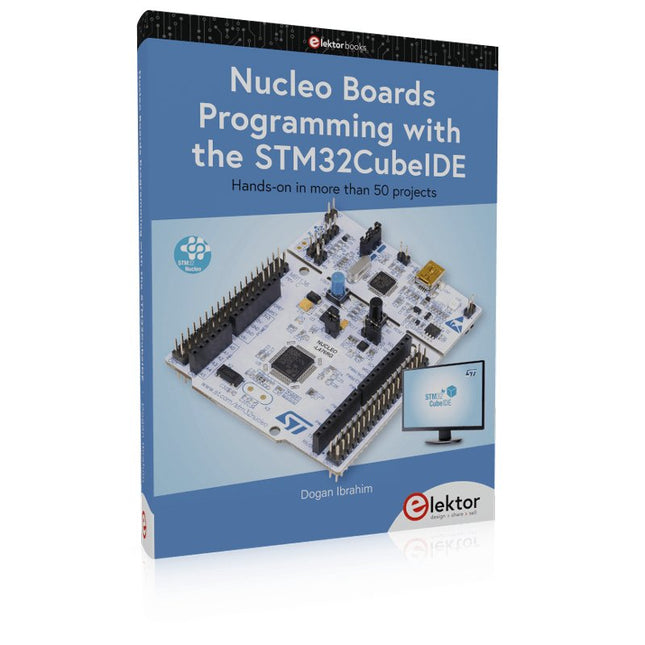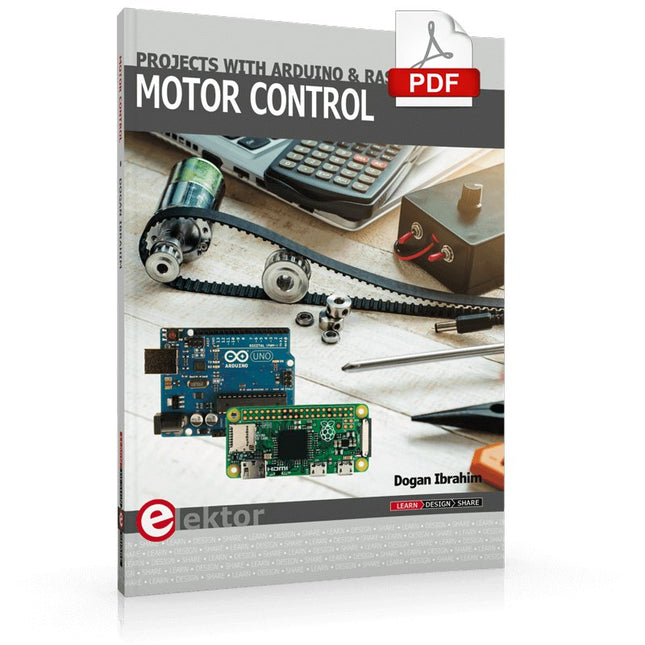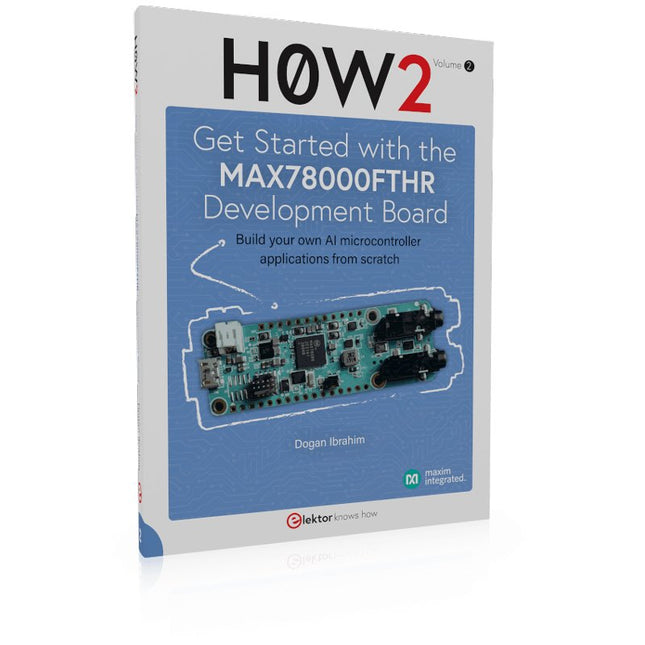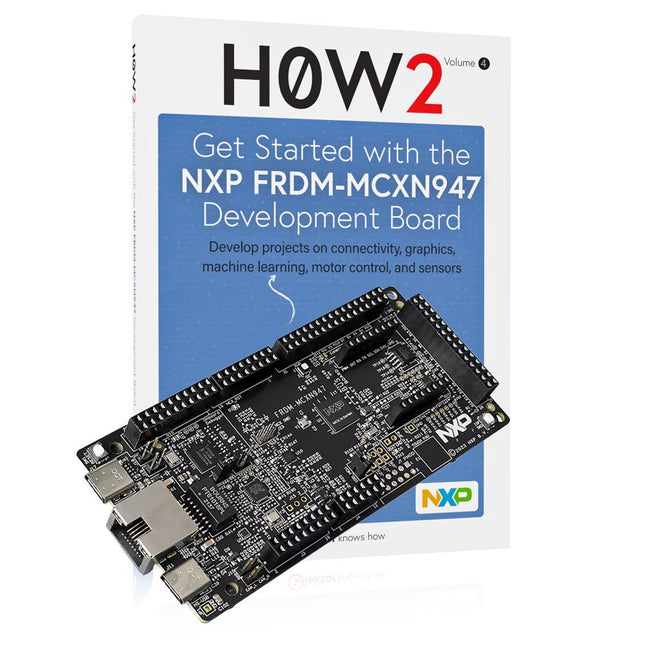Suchergebnisse für "geekcreit OR 5pcs OR 5v OR stepper OR motor OR with OR uln2003 OR driver OR board OR dupont OR cable"
-

Kitronik Kitronik Motor Driver Board for Raspberry Pi Pico
Dieses Board ermöglicht es dem Raspberry Pi Pico (angeschlossen über die Stiftleiste), zwei Motoren gleichzeitig mit voller Vorwärts-, Rückwärts- und Stoppsteuerung anzutreiben, was es ideal für Pico-gesteuerte Buggy-Projekte macht. Alternativ kann die Platine auch zum Betrieb eines Schrittmotors verwendet werden. Die Platine ist mit dem Motortreiber-IC DRV8833 ausgestattet, der über einen integrierten Kurzschluss-, Überstrom- und Wärmeschutz verfügt. Die Platine hat 4 externe Anschlüsse für GPIO-Pins und eine 3-V- und GND-Versorgung vom Pico. Dies ermöglicht zusätzliche IO-Optionen für Ihre Buggy-Bauten, die vom Pico gelesen oder gesteuert werden können. Außerdem gibt es einen Ein/Aus-Schalter und eine Power-Status-LED, so dass Sie auf einen Blick sehen können, ob das Board eingeschaltet ist, und Ihre Batterien schonen können, wenn Ihr Projekt nicht in Gebrauch ist. Um die Motortreiberplatine verwenden zu können, muss der Pico über eine verlötete Stiftleiste verfügen und fest in den Stecker eingesteckt werden. Die Platine erzeugt eine geregelte Stromversorgung, die in den 40-poligen Stecker eingespeist wird, um den Pico mit Strom zu versorgen, so dass dieser nicht direkt mit Strom versorgt werden muss. Die Motortreiberplatine wird entweder über Schraubklemmen oder einen Servostecker versorgt. Kitronik hat ein Micro-Python Modul und Beispielcode entwickelt, um die Verwendung des Motor Driver Boards mit dem Pico zu unterstützen. Dieser Code ist im GitHub Repo verfügbar. Merkmale Ein kompaktes und dennoch funktionsreiches Board, das als Herzstück Ihrer Raspberry Pi Pico Roboter-Buggy-Projekte entwickelt wurde. Die Platine kann 2 Motoren gleichzeitig mit voller Vorwärts-, Rückwärts- und Stoppsteuerung antreiben. Sie enthält den Motortreiber-IC DRV8833, der über einen integrierten Kurzschluss-, Überstrom- und Überhitzungsschutz verfügt. Darüber hinaus verfügt die Platine über einen Ein/Aus-Schalter und eine Power-Status-LED. Die Stromversorgung der Platine erfolgt über einen Klemmenleistenanschluss. Die 3V- und GND-Pins sind ebenfalls herausgebrochen, so dass externe Geräte mit Strom versorgt werden können. Programmieren Sie es mit MicroPython über einen Editor wie den Thonny-Editor. Abmessungen: 63 mm (L) x 35 mm (B) x 11,6 mm (H) Download Datenblatt
€ 15,95€ 7,95
Mitglieder identisch
-

Elektor Publishing Nucleo Boards Programming with the STM32CubeIDE
Hands-on in more than 50 projects STM32 Nucleo family of processors are manufactured by STMicroelectronics. These are low-cost ARM microcontroller development boards. This book is about developing projects using the popular STM32CubeIDE software with the Nucleo-L476RG development board. In the early Chapters of the book the architecture of the Nucleo family is briefly described. The book covers many projects using most features of the Nucleo-L476RG development board where the full software listings for the STM32CubeIDE are given for each project together with extensive descriptions. The projects range from simple flashing LEDs to more complex projects using modules, devices, and libraries such as GPIO, ADC, DAC, I²C, SPI, LCD, DMA, analogue inputs, power management, X-CUBE-MEMS1 library, DEBUGGING, and others. In addition, several projects are given using the popular Nucleo Expansion Boards. These Expansion Boards plug on top of the Nucleo development boards and provide sensors, relays, accelerometers, gyroscopes, Wi-Fi, and many others. Using an expansion board together with the X-CUBE-MEMS1 library simplifies the task of project development considerably. All the projects in the book have been tested and are working. The following sub-headings are given for each project: Project Title, Description, Aim, Block Diagram, Circuit Diagram, and Program Listing for the STM32CubeIDE. In this book you will learn about STM32 microcontroller architecture; the Nucleo-L476RG development board in projects using the STM32CubeIDE integrated software development tool; external and internal interrupts and DMA; DEBUG, a program developed using the STM32CubeIDE; the MCU in Sleep, Stop, and in Standby modes; Nucleo Expansion Boards with the Nucleo development boards. What you need a PC with Internet connection and a USB port; STM32CubeIDE software (available at STMicroelectronics website free of charge) the project source files, available from the book’s webpage hosted by Elektor; Nucleo-L476RG development board; simple electronic devices such as LEDs, temperature sensor, I²C and SPI chips, and a few more; Nucleo Expansion Boards (optional).
€ 49,95
Mitglieder € 44,96
-

Generic ESP32 Cheap Yellow Display Board
Dieses Entwicklungsboard (auch bekannt als "Cheap Yellow Display") wird vom ESP-WROOM-32 angetrieben, einem Dual-Core-MCU mit integrierten Wi-Fi- und Bluetooth-Funktionen. Es arbeitet mit einer Hauptfrequenz von bis zu 240 MHz, mit 520 KB SRAM, 448 KB ROM und einem 4 MB Flash-Speicher. Das Board verfügt über ein 2,8" Display mit einer Auflösung von 240x320 und Resistive Touch. Darüber hinaus enthält die Platine einen Steuerkreis für die Hintergrundbeleuchtung, einen Schaltkreis für die Berührungssteuerung, einen Schaltkreis für die Lautsprecheransteuerung, einen lichtempfindlichen Schaltkreis und einen RGB-LED-Steuerschaltkreis. Es bietet außerdem einen TF-Kartensteckplatz, eine serielle Schnittstelle, eine DHT11-Schnittstelle für Temperatur- und Feuchtigkeitssensoren und zusätzliche E/A-Anschlüsse. Das Modul unterstützt die Entwicklung in Arduino IDE, ESP-IDE, MicroPython und Mixly. Anwendungen Bildübertragung für Smart Home-Gerät Drahtlose Überwachung Intelligente Landwirtschaft QR-Funkerkennung Signal des drahtlosen Positionierungssystems Und andere IoT-Anwendungen Technische Daten Mikrocontroller ESP-WROOM-32 (Dual-Core-MCU mit integriertem WLAN und Bluetooth) Frequenz Bis zu 240 MHz (Rechenleistung bis zu 600 DMIPS) SRAM 520 KB ROM 448 KB Flash 4 MB Betriebsspannung 5 V Stromverbrauch ca. 115 mA Display 2,8" TFT-Farbbildschirm (240 x 320) Touch Resistive Touch Treiberchip ILI9341 Abmessungen 50 x 86 mm Gewicht 50 g Lieferumfang 1x ESP32 Dev-Board mit 2,8" Display und Acrylgehäuse 1x Touch-Stift 1x Verbindungskabel 1x USB-Kabel Downloads GitHub
€ 24,95
Mitglieder € 22,46
-

SparkFun SparkFun moto:bit - micro:bit Carrier Board (Qwiic)
Auf jedem moto:bit befinden sich mehrere I/O-Pins sowie ein vertikaler Qwiic-Anschluss, an den Servos, Sensoren und andere Schaltungen angeschlossen werden können. Auf Knopfdruck können Sie Ihr moto:bit in Bewegung setzen! Das moto:bit wird mit dem micro:bit über einen aktualisierten SMD-Steckverbinder an der Oberseite des Boards verbunden, was die Einrichtung erleichtert. Dies schafft eine praktische Möglichkeit, micro:bits für die Programmierung auszutauschen und bietet gleichzeitig zuverlässige Verbindungen zu allen verschiedenen Pins auf dem micro:bit. Wir haben auch eine einfache Barrel-Buchse auf dem moto:bit integriert, die in der Lage ist, alles mit Strom zu versorgen, was Sie an das Carrier Board anschließen. Features Zuverlässigerer Edge-Anschluss für die einfache Verwendung mit dem micro:bit Vollständige H-Brücke zur Steuerung von zwei Motoren Steuerung von Servomotoren Vertikaler Qwiic-Anschluss I2C-Anschluss zur Erweiterung der Funktionalität Strom- und Batteriemanagement onboard für den micro:bit
€ 109,95€ 54,95
Mitglieder identisch
-

Elektor Digital Motor Control - Projects with Arduino & Raspberry Pi (E-book)
This book is about DC electric motors and their use in Arduino and Raspberry Pi Zero W based projects. The book includes many tested and working projects where each project has the following sub-headings: Title of the project Description of the project Block diagram Circuit diagram Project assembly Complete program listing of the project Full description of the program The projects in the book cover the standard DC motors, stepper motors, servo motors, and mobile robots. The book is aimed at students, hobbyists, and anyone else interested in developing microcontroller based projects using the Arduino Uno or the Raspberry Pi Zero W. One of the nice features of this book is that it gives complete projects for remote control of a mobile robot from a mobile phone, using the Arduino Uno as well as the Raspberry Pi Zero W development boards. These projects are developed using Wi-Fi as well as the Bluetooth connectivity with the mobile phone. Readers should be able to move a robot forward, reverse, turn left, or turn right by sending simple commands from a mobile phone. Full program listings of all the projects as well as the detailed program descriptions are given in the book. Users should be able to use the projects as they are presented, or modify them to suit to their own needs.
€ 29,95
Mitglieder € 23,96
-

Elektor Digital Programming with STM32 Nucleo Boards (E-book)
STM32 Nucleo family of processors are manufactured by STMicroelectronics. These are low-cost ARM microcontroller development boards. This book is about developing projects using the popular Nucleo development board. In the early chapters of the book, the architecture of the Nucleo family is briefly described. Software development tools that can be used with the Nucleo boards such as the Mbed, Keil MDK, TrueSTUDIO, and the System Workbench are described briefly in later Chapters. The book covers many projects using most features of the STM32 Nucleo development boards where the full software listings for Mbed and System Workbench are given for every project. The projects range from simple flashing LEDs to more complex projects using modules and devices such as GPIO, ADC, DAC, I²C, LCD, analog inputs and others. In addition, several projects are given using the Nucleo Expansion Boards, including popular expansion boards such as solid-state relay, MEMS and environmental sensors, DC motor driver, Wi-Fi, and stepper motor driver. These Expansion Boards plug on top of the Nucleo development boards and simplify the task of project development considerably. Features of this book Learn the architecture of the STM32 microcontrollers Learn how to use the Nucleo development board in projects using Mbed and System Workbench Toolchains Learn how to use the Nucleo Expansion Boards with the Nucleo development boards Update The Mbed compiler has been replaced with two software packages: The Mbed Studio and Keil Studio Cloud. Both of these software packages are free of charge and are available on the Internet. If you need assistance using the Keil Studio Cloud, please download the Guide below.
€ 34,95
Mitglieder € 27,96
-

Luckfox LuckFox Pico Ultra Linux Micro Development Board
Der LuckFox Pico Ultra ist ein kompakter Single-Board-Computer (SBC) mit dem Rockchip RV1106G3-Chipsatz, der für KI-Verarbeitung, Multimedia und stromsparende Embedded-Anwendungen entwickelt wurde. Er ist mit einer integrierten 1-TOPS-NPU ausgestattet und eignet sich daher ideal für Edge-KI-Workloads. Mit 256 MB RAM, 8 GB Onboard-eMMC-Speicher, integriertem WLAN und Unterstützung für das LuckFox PoE-Modul bietet das Board Leistung und Vielseitigkeit für eine Vielzahl von Anwendungsfällen. Der LuckFox Pico Ultra läuft unter Linux und unterstützt eine Vielzahl von Schnittstellen – darunter MIPI CSI, RGB-LCD, GPIO, UART, SPI, I²C und USB – und bietet so eine einfache und effiziente Entwicklungsplattform für Anwendungen in den Bereichen Smart Home, Industriesteuerung und IoT. Technische Daten Chip Rockchip RV1106G3 Prozessor Cortex-A7 1,2 GHz Neuronaler Netzwerkprozessor (NPU) 1 TOPS, unterstützt int4, int8, int16 Bildprozessor (ISP) Max. Eingangsgeschwindigkeit 5 M @30fps Speicher 256 MB DDR3L WLAN + Bluetooth 2,4 GHz WiFi-6 Bluetooth 5.2/BLE Kameraschnittstelle MIPI CSI 2-Lane DPI-Schnittstelle RGB666 PoE-Schnittstelle IEEE 802.3af PoE Lautsprecherschnittstelle MX1,25 mm USB USB 2.0 Host/Gerät GPIO 30 GPIO Pins Ethernet 10/100M Ethernet-Controller und eingebetteter PHY Standardspeichermedium eMMC (8 GB) Lieferumfang 1x LuckFox Pico Ultra W 1x LuckFox PoE Modul 1x IPX 2,4G 2 dB Antenne 1x USB-A auf USB-C Kabel 1x Schraubensatz Downloads Wiki
€ 39,95€ 19,95
Mitglieder identisch
-

Elektor Publishing H0W2: Get Started with the MAX78000FTHR Development Board
Build your own AI microcontroller applications from scratch The MAX78000FTHR from Maxim Integrated is a small development board based on the MAX78000 MCU. The main usage of this board is in artificial intelligence applications (AI) which generally require large amounts of processing power and memory. It marries an Arm Cortex-M4 processor with a floating-point unit (FPU), convolutional neural network (CNN) accelerator, and RISC-V core into a single device. It is designed for ultra-low power consumption, making it ideal for many portable AI-based applications. This book is project-based and aims to teach the basic features of the MAX78000FTHR. It demonstrates how it can be used in various classical and AI-based projects. Each project is described in detail and complete program listings are provided. Readers should be able to use the projects as they are, or modify them to suit their applications. This book covers the following features of the MAX78000FTHR microcontroller development board: Onboard LEDs and buttons External LEDs and buttons Using analog-to-digital converters I²C projects SPI projects UART projects External interrupts and timer interrupts Using the onboard microphone Using the onboard camera Convolutional Neural Network
€ 39,95
Mitglieder € 35,96
-

NXP Semiconductors NXP FRDM-MCXN947 Development Board
The FRDM-MCXN947 is a compact and versatile development board designed for rapid prototyping with MCX N94 and N54 microcontrollers. It features industry-standard headers for easy access to the MCU's I/Os, integrated open-standard serial interfaces, external flash memory, and an onboard MCU-Link debugger. Technische Daten Microcontroller MCX-N947 Dual Arm Cortex-M33 cores @ 150 MHz each with optimized performance efficiency, up to 2 MB dual-bank flash with optional full ECC RAM, External flash Accelerators: Neural Processing Unit, PowerQuad, Smart DMA, etc. Memory Expansion *DNP Micro SD card socket Connectivity Ethernet Phy and connector HS USB-C connectors SPI/I²C/UART connector (PMOD/mikroBUS, DNP) WiFi connector (PMOD/mikroBUS, DNP) CAN-FD transceiver Debug On-board MCU-Link debugger with CMSIS-DAP JTAG/SWD connector Sensor P3T1755 I³C/I²C Temp Sensor, Touch Pad Expansion Options Arduino Header (with FRDM expansion rows) FRDM Header FlexIO/LCD Header SmartDMA/Camera Header Pmod *DNP mikroBUS User Interface RGB user LED, plus Reset, ISP, Wakeup buttons Lieferumfang 1x FRDM-MCXN947 Development Board 1x USB-C Cable 1x Quick Start Guide Downloads Datasheet Block diagram
€ 29,95€ 14,95
Mitglieder identisch
-

Elektor Bundles Get Started with the NXP FRDM-MCXN947 Development Board (Bundle)
Dieses Bundle enthält: Buch: Get Started with the NXP FRDM-MCXN947 Development Board (Einzelpreis: 40 €) NXP FRDM-MCXN947 Development Board (Einzelpreis: 30 €) Buch: Get Started with the NXP FRDM-MCXN947 Development Board Projekte zu Konnektivität, Grafik, maschinellem Lernen, Motorsteuerung und Sensoren entwickeln Dieses (englischsprachige) Buch behandelt die Verwendung des FRDM-MCXN947 Development Boards, entwickelt von NXP Semiconductors. Es integriert den Dual Arm Cortex-M33, der mit bis zu 150 MHz arbeitet. Ideal für industrielle, IoT- und maschinelles Lernen-Anwendungen. Es verfügt über Hi-Speed USB, CAN 2.0, I³C und 10/100 Ethernet. Das Board beinhaltet einen integrierten MCU-Link-Debugger, FlexI/O zur Steuerung von LCDs und Dual-Bank-Flash für Lese-und-Schreib-Operationen, mit Unterstützung für große externe serielle Speicherkonfigurationen. Eine der wichtigen Funktionen des Entwicklungsboards ist die integrierte eIQ Neutron Neural Processing Unit (NPU), die es den Nutzern ermöglicht, AI-basierte Projekte zu entwickeln. Das Entwicklungsboard unterstützt auch Arduino Uno-Header-Pins, was es mit vielen Arduino-Shields kompatibel macht, sowie einen mikroBUS-Anschluss für MikroElektronika Click Boards und einen Pmod-Anschluss. Ein weiterer Vorteil des FRDM-MCXN947 Development Boards ist, dass es mehrere integrierte Debug-Probes enthält, die es Programmierern ermöglichen, ihre Programme direkt mit dem MCU zu debuggen. Mit Hilfe des Debuggers können Programmierer Schritt für Schritt durch ein Programm gehen, Breakpoints setzen, Variablen ansehen und ändern, und vieles mehr. Im Buch wurden viele funktionierende und getestete Projekte mit der beliebten MCUXpresso IDE und dem SDK unter Verwendung verschiedener Sensoren und Aktoren entwickelt. Auch die Verwendung der populären CMSIS-DSP-Bibliothek wird anhand mehrerer häufig genutzter Matrixoperationen erklärt. Die im Buch bereitgestellten Projekte können ohne Änderungen in vielen Anwendungen eingesetzt werden. Alternativ können die Leser ihre eigenen Projekte auf den im Buch vorgestellten Projekten aufbauen, während sie ihre eigenen Projekte entwickeln. NXP FRDM-MCXN947 Development Board TDas FRDM-MCXN947 ist ein kompaktes und vielseitiges Entwicklungsboard, das für das Rapid Prototyping mit MCX N94- und N54-Mikrocontrollern konzipiert wurde. Es verfügt über Industriestandard-Header für den einfachen Zugang zu den I/Os der MCU, integrierte serielle Schnittstellen nach offenem Standard, externen Flash-Speicher und einen Onboard-MCU-Link-Debugger. Technische Daten Mikrocontroller MCX-N947 Dual Arm Cortex-M33-Kerne mit jeweils 150 MHz und optimierter Leistungseffizienz, bis zu 2 MB Dual-Bank-Flash mit optionalem Full-ECC-RAM, externer Flash Beschleuniger: Neural Processing Unit, PowerQuad, Smart DMA usw. Speichererweiterung *DNP MicroSD-Kartensteckplatz Konnektivität Ethernet Phy und Connector HS USB-C-Anschlüsse SPI/I²C/UART-Anschluss (PMOD/mikroBUS, DNP) WiFi-Anschluss (PMOD/mikroBUS, DNP) CAN-FD-Transceiver Debuggen Integrierter MCU-Link-Debugger mit CMSIS-DAP JTAG/SWD-Anschluss Sensor P3T1755 I³C/I²C-Temperatursensor, Touchpad Erweiterungsoptionen Arduino-Header (mit FRDM-Erweiterungszeilen) FRDM-Header FlexIO/LCD-Header SmartDMA/Kamera-Header Pmod *DNP mikroBUS Benutzeroberfläche RGB-Benutzer-LED sowie Reset-, ISP- und Wakeup-Tasten Lieferumfang 1x FRDM-MCXN947 Development Board 1x USB-C Kabel 1x Quick Start Guide Downloads Datasheet Block diagram
€ 69,95€ 29,95
Mitglieder identisch
-

Elektor Digital Power Electronics in Motor Drives (E-book)
This book is for people who want to understand how AC drives (also known as inverter drives) work and how they are used in industry by showing mainly the practical design and application of drives. The key principles of power electronics are described and presented in a simple way, as are the basics of both DC and AC motors. The different parts of an AC drive are explained, together with the theoretical background and the practical design issues such as cooling and protection. An important part of the book gives details of the features and functions often found in AC drives and gives practical advice on how and where to use these. Also described is future drive technology, including a matrix inverter. The mathematics is kept to an essential minimum. Some basic understanding of mechanical and electrical theory is presumed, and a basic knowledge of single andthree phase AC systems would be useful. Anyone who uses or installs drives, or is just interested in how these powerful electronic products operate and control modern industry, will find this book fascinating and informative.
€ 29,95
Mitglieder € 23,96
-

SparkFun SparkFun Power Delivery Board - USB-C (Qwiic)
Das Power Delivery Board verwendet einen eigenständigen Controller, um mit den Stromadaptern zu verhandeln und auf eine höhere Spannung als nur 5V umzuschalten. Dies verwendet den gleichen Stromadapter für verschiedene Projekte, anstatt sich auf mehrere Stromadapter zu verlassen, die unterschiedliche Ausgangsspannungen bereitstellen. Das Board kann als Teil des Qwiic-Connect-Systems von SparkFun geliefert werden, so dass Sie keine Lötarbeiten durchführen müssen, um herauszufinden, wie die Dinge ausgerichtet sind. Das SparkFun Power Delivery Board nutzt die Vorteile des Power-Delivery-Standards mit einem Standalone-Controller von STMicroelectronics, dem STUSB4500. Der STUSB4500 ist ein USB-Power-Delivery-Controller, der Senkengeräte anspricht. Er implementiert einen proprietären Algorithmus zur Aushandlung eines Stromversorgungsvertrags mit einer Quelle (d. h. einer Steckdose oder einem Netzteil), ohne dass ein externer Mikrocontroller erforderlich ist. Sie benötigen jedoch einen Mikrocontroller, um die Karte zu konfigurieren. PDO-Profile werden in einem integrierten nichtflüchtigen Speicher konfiguriert. Der Controller übernimmt die ganze Arbeit der Leistungsaushandlung und bietet eine einfache Möglichkeit zur Konfiguration über I2C. Um die Karte zu konfigurieren, benötigen Sie einen I2C-Bus. Das Qwiic-System macht es einfach, das Power Delivery Board mit einem Mikrocontroller zu verbinden. Je nach Anwendung können Sie den I2C-Bus auch über die durchkontaktierten SDA- und SCL-Löcher anschließen. Merkmale Eingangs- und Ausgangsspannungsbereich von 5-20V Ausgangsstrom bis zu 5A Drei konfigurierbare Stromabgabeprofile Automatischer Type-C™- und USB-PD-Sink-Controller Zertifizierter USB Type-C™ rev 1.2 und USB PD rev 2.0 (TID #1000133) Integrierte VBUS-Spannungsüberwachung Integrierte VBUS-Switch-Gate-Treiber (PMOS)
€ 34,95€ 17,50
Mitglieder identisch











